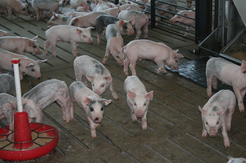 What is it? Pigs
are the natural host for this viral disease (contagious herpesvirus), and it
can also affect other mammals, like cattle, sheep, goats, cats, dogs, and wild
animals. Younger animals die of the disease more frequently than older animals,
often within two to three days of infection. Older animals will get sick and
usually recover within a week or two, although some occasionally die. The U.S.
has a pseudorabies eradication program to protect livestock from the disease,
which was last found in a commercial swine herd in 2003.
How is it
transmitted? The virus mainly moves between animals through direct contact
with an infected animal. Nose-to-nose is believed to be the most common route
leading to infection. Studies point to environmental transmission, including
water, also being a risk because the virus can survive for short periods of
time on equipment and even in the air, if conditions are right.
What are the signs
in animals? Age is an important factor in identifying the signs of a
pseudorabies infected animal. Weight loss is a common sign in animals of any
age and unfortunately, the first sign in younger animals may often be death.
Older pigs may exhibit fever, sneezing, loss of appetite, and other respiratory
issues. Non-swine species will have similar signs, and often have an irritated
area on their skin that they continually itch. The itchy patch of skin is the
reason pseudorabies may also be known as “mad itch.”
How is it
diagnosed? Diagnosis in young swine and other animal species is frequently
conducted after the animal already died from the disease. To confirm the
disease, veterinarians collect blood samples and conduct a serologic test. This
type of testing works by looking for antibodies produced by the animal’s immune
system, which show scientists if the animal’s immune system was responding to
an infection.
What is the
treatment? There is no standard treatment available for pseudorabies. However,
vaccination is the best way to reduce the symptoms of the disease and reduce
the risk of it spreading between animals.
How can it be
prevented? In addition to vaccination, all new animals entering a herd
should be tested before being allowed into the herd. Approximately 20-percent
of feral swine in the U.S. are seropositive (a positive test result for
exposure to a virus in the blood). The U.S. has a surveillance program in place
to monitor pseudorabies in wild pigs. This program helps by keeping wild and
domestic herds separate to reduce the risk of disease transmission.
Is there a risk to
people? There have been no reported cases or symptoms in people. However,
proper biosecurity should always be practiced to protect animals, their
environment, and the people working in their environment.
|